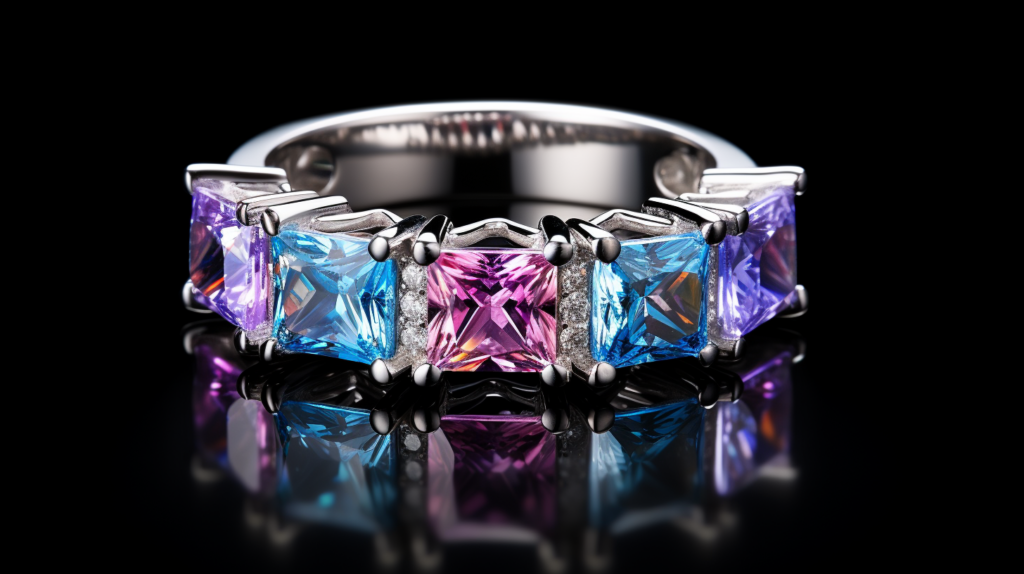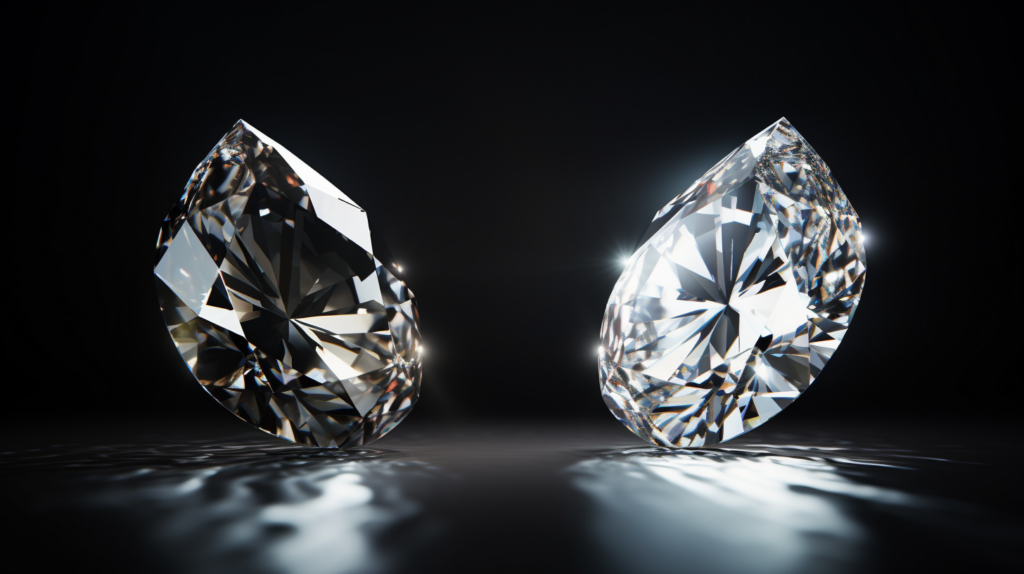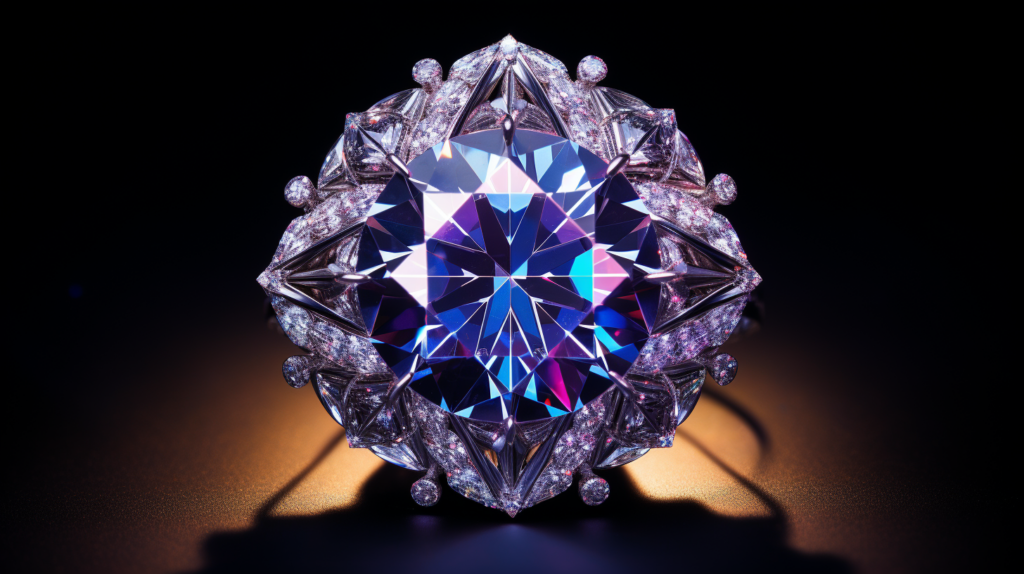Welcome to our full upgraded diamond guide. We’ll delve into the characteristics of enhanced diamonds, from their optical properties to their clarity grades. Their distinctive features, the process of clarity enhancement, and how to tell them apart from natural stones will be the focus of this guide.
Enhanced diamonds are increasingly becoming a sought-after choice for many, especially for those looking to achieve the brilliance of a real diamond without spending a fortune. Not only are these diamonds more affordable, but their clean and bright white appearance also makes them an attractive option for many savvy diamond buyers. However, it’s crucial to remember that enhanced diamonds undergo various treatments to elevate their clarity and color, setting them apart from untreated diamonds or natural diamonds.
Journey with us in this Enhanced Diamonds Guide by BrighterGuide as we unfold the secrets behind enhanced diamonds and offer insights to help you make an informed choice.
Related article: Emerald Cut Diamond Guide
Key Takeaways
- Enhanced diamonds undergo treatments like laser drilling and fracture filling to improve clarity and color, making them more affordable and attractive to buyers.
- Certain indicators, such as unparalleled brilliance and size discrepancies, can hint at a diamond being enhanced rather than natural.
- Clarity-enhanced diamonds provide a budget-friendly option for high-quality gems but come with potential drawbacks related to durability and treatment longevity.

What Are Enhanced Diamonds?
Enhanced diamonds have an intriguing history spanning several decades. Unlike natural diamonds or non-enhanced diamonds, these gems undergo treatments to elevate their appearance. From laser drilling to fracture filling and even sophisticated surface coatings, a wide variety of treatments exist that can significantly boost the diamond’s clarity, color, and overall value. This makes them an exceptional and affordable alternative to larger diamonds, especially for those who desire the allure of a high-quality diamond without the associated carat weight cost.
The History Of Enhanced Diamonds
As we journey back in time, we uncover the fascinating narrative behind the enhancement of diamonds. The diamond industry sought ways to magnify the beauty of diamonds that had certain flaws or inclusions. This led to the discovery of techniques like crack filling, where a glass-like resin is injected into the diamond, acting as a filler to seal microscopic fissures, a process often referred to as the fracture filling process.
Then there’s laser drilling, a technique that harnesses the power of a laser beam to target and eliminate black inclusions or imperfections, enhancing the diamond’s clarity. Through these clarity treatments and advancements in diamond synthesis, the optical properties of diamonds have been significantly improved, transforming them into more desirable and valuable gemstones.
How Are Enhanced Diamonds Made
To fully grasp how enhanced diamonds come to be, one must delve into their intricate treatment processes. These diamonds, often referred to by diamond experts as treated diamonds, are crafted to perfection in well-equipped gemological laboratories.
One popular method is laser drilling. By using a laser beam, diamond experts can target and eliminate black carbon spots, resulting in a diamond with heightened clarity that’s perfect for diamond jewelry. This laser drilling technique is both intricate and precise, ensuring the preservation of the diamond’s natural beauty.
Fracture filling, another common technique, involves injecting the diamond with a unique glass-like resin. This not only fills and seals microscopic fissures but also significantly improves the diamond’s clarity grade. However, it’s vital to note that certain chemicals used in this process can sometimes produce unintended results, like giving the diamond a slightly glassy appearance.
Another noteworthy process is High-pressure high-temperature (HPHT). Through this method, diamonds, even rough diamonds, can be transformed. HPHT mimics the Earth’s natural diamond-creating conditions, either coloring or brightening diamonds. Interestingly, it’s essential to mention that this same HPHT process is crucial in the creation of lab-created diamonds or lab-grown diamonds.
To the average consumer, the world of enhanced and lab-made diamonds might seem intricate, but with a bit of knowledge, it’s easy to appreciate the craftsmanship and innovation that goes into creating these beautiful stones. Whether you’re considering a diamond ring or any other piece of diamond jewelry, understanding the world of enhanced diamonds ensures you make an informed and confident decision.

How Can You Tell If A Diamond Is Enhanced
There are a multitude of indicators suggesting a diamond may have received clarity treatments or enhancements.
To start, enhanced diamonds have a particular radiance that can sometimes surpass the brilliance of natural diamonds. When a diamond seems almost too flawless, devoid of the usual inclusions or blemishes that come with a natural stone, it could be an indicator of diamond treatment processes. Moreover, some procedures aim to make enhanced diamonds look larger than their actual carat weight.
Let’s delve deeper into these signals which might hint at diamond enhancement.
The Diamond Is Surprisingly Bright
When you encounter an augmented diamond, the sheer brilliance and clarity of diamonds could be immediately evident. This is a result of the clarity enhancement process that these diamonds go through. Here’s how you can differentiate:
A clarity-enhanced diamond may outshine even the most brilliant diamond.
They typically appear cleaner and more flawless than untreated diamonds.
Enhanced stones might exhibit more vivid spectral colors than their untreated counterparts.
Uniform material and color are more common in enhanced diamonds.
Cost-wise, an enhanced stone might be priced lower than its equivalent in natural diamonds.
Understanding these characteristics can offer clarity on the type of diamond you’re examining.
The Diamond Is Too Perfect To Be Natural
To the trained eye of diamond experts, identifying an enhanced diamond is straightforward based on its perfection. However, the average consumer can still pick up on some telltale signs. Here’s a simple table that illustrates the differences between a non-enhanced diamond and an enhanced stone:
| Non-Enhanced Diamond | Enhanced Stone |
| Might have a heavier carat weight | Carat weight generally remains consistent |
| Untouched, original diamond | Undergoes color enhancement |
| No clarity treatments | Clarity treatments are common |
| Grading reports might show no enhancements | Grading reports might indicate enhancements |
The Diamond May Be Larger
The diamond’s size and weight can sometimes be misleading, especially when it comes to enhanced diamonds. Here are some methods to help identify a diamond that might have undergone size or clarity enhancement:
Real Diamond vs Lab-Grown Diamond: Always ensure the diamond is not a lab-created diamond or synthetic diamonds, as these differ from enhanced diamonds.
Comparing Sizes: Enhanced diamonds might appear more significant than a non-enhanced diamond of the same carat weight, providing more bang for your buck.
Biggest Diamond For Your Buck: Enhanced diamonds might allow you to purchase a 1-carat diamond or even a 2-carat diamond without stretching your budget.
Inclusions: Black carbon inclusions or spots in the diamond could be a result of internal laser drilling, hinting at enhancement.
Carat Weight Loss: Certain clarity enhancement processes may lead to a slight decrease in the diamond’s carat weight.
Caring For Your Enhanced Diamond
Whether you opt for an untreated diamond or an enhanced one, proper care is paramount. Consult with a trusted jeweler or the Gemological Institute of America for advice. To maintain its shine and optical properties, clean it using a jewelry cleaner, preferably with a soft toothbrush, and avoid harsh or acidic chemicals that could damage its surface layer.

Quality and durability of clarity-enhanced diamonds
Clarity-enhanced diamonds, sometimes likened to lab-grown or lab-created diamonds, are diamonds that undergo specific treatments to boost their quality and ensure their longevity. These treatments encompass various processes such as fracture filling, a procedure widely used in the diamond industry, and internal laser drilling, often using a focused laser beam.
Fracture filling involves the meticulous injection of a glass-like resin into the diamond’s structure. This process serves to effectively seal any microscopic fissures present, not only rectifying the appearance of inclusions on diamonds but also fortifying its structure. This enhancement contributes significantly to the improved optical properties of the diamond. However, on rare occasions, certain fillers used during the fracture filling process might induce flaws or lend the diamond a slightly glassy appearance.
Internal laser drilling, on the other hand, addresses diamond inclusions by utilizing a precise laser beam technique to diminish or entirely eliminate them, thus improving the diamond’s clarity grade. This laser drilling technique does not compromise the diamond’s intrinsic hardness or strength.
In certain clarity enhancement processes, the diamond surface might undergo surface pretreatment to ensure an efficient bond with the filler material, which in turn improves the material properties of the enhanced diamond.
Pros and Cons of Clarity Enhanced Diamonds
The allure of clarity-enhanced diamonds lies in their affordability, especially when compared to natural diamonds or non-enhanced diamonds. Such enhancements provide a cost-effective avenue for diamond buyers and savvy diamond lovers looking for larger diamonds, perhaps a 1-carat diamond or even a 2-carat diamond, without the hefty price tag. Enhanced diamonds, through techniques like color enhancement, can manifest as pristine, colorless diamonds, offering impeccable clarity of diamonds at a fraction of the cost. For the average consumer, especially the budget-conscious ones, clarity-enhanced diamonds could be an optimal choice to get brilliant diamond jewelry without burning a hole in their pocket.
However, like all things, clarity-enhanced diamonds come with their own set of drawbacks. Over time, certain treatments might wear off, causing the diamond to lose its luster or, in extreme cases, even crack. Furthermore, certain chemicals, such as acidic chemicals or even common cleaning solutions like ammonia, can be detrimental to enhanced diamonds. Elevated temperatures might also pose a threat, potentially complicating repair or resizing procedures for diamond rings or other diamond jewelry. Moreover, grading laboratories, including reputed ones like the Gemological Institute of America, often refrain from issuing permanent grading reports for these diamonds due to the non-permanent nature of some of these treatments.

Price of Enhanced Diamonds
Price is crucial when buying clarity-enhanced diamonds. An enhanced diamond costs about half as much as a regular diamond.
This affordability lets you buy a larger carat weight or better quality on a budget.
Should you purchase clarity-enhanced diamonds
Before buying improved diamonds, we should evaluate their price. Consider these key factors:
Clarity-enhanced diamonds are 30–50% cheaper than natural diamonds.
Feather filling improves the purity of these gems. Diamond inclusions can be filled to hide them.
Clarity-Enhanced Diamond Grading: Well-equipped gemological laboratories can report fracture-filled diamonds, helping you evaluate treatment and make a decision.
Clarity-enhanced diamonds can fade and crack, but with appropriate care, they can last a long time.
Value: Smart diamond purchasers can acquire high-quality clarity-enhanced diamonds at great prices.
Consider these facts before buying clarity-enhanced diamonds. It depends on your budget, style, and interests.
Conclusion
In conclusion, improved diamonds offer value for money and the chance to have a higher carat weight or better quality on a budget. Enhancing diamonds by laser drilling, fracture filling, or high-pressure high-temperature treatment improves clarity and color. They can get an expensive-looking appearance this way. For affordable colorless diamonds, enhanced diamonds may be a good choice.
Diamonds should be chosen based on clarity, color, and ethics. Enhanced and lab-made diamonds are conflict-free alternatives to mined diamonds. They offer a sustainable alternative for diamond miners concerned about the environment and society.
Enhance diamonds are cheaper than natural diamonds, so people can buy a larger, higher-quality diamond.
Sources
BrighterGuide is dedicated to providing accurate and relevant information as you explore the wonderful world of diamonds and jewelry. To this end, our writers refer to primary information sources in building each article that appears on this website. These include, but are not limited to, published news articles, government portals, research papers, and more.
- Good Old Gold. (n.d.). Clarity enhanced diamonds. https://www.goodoldgold.com/clarity-enhanced-diamonds
- What are clarity enhanced diamonds | London Gold. (n.d.). London Gold. https://www.londongold.com/about/clarity-enhanced-diamonds/